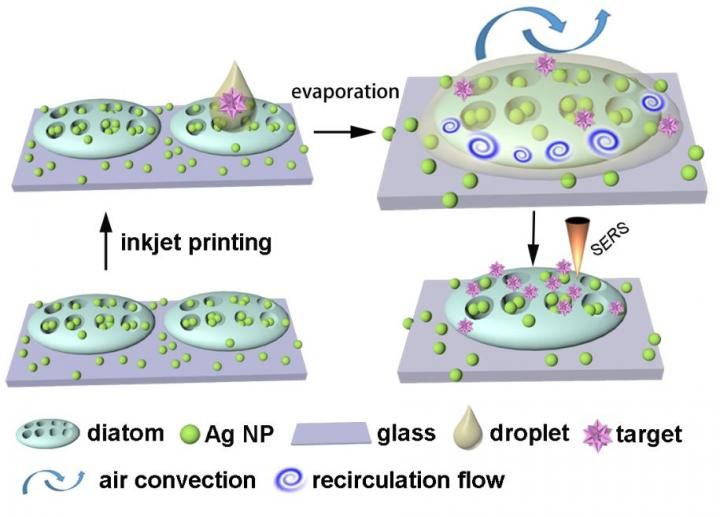New technology taps power of diatoms to dramatically improve sensor performance
Researchers at Oregon State University have combined one of nature's tiny miracles, the diatom, with a version of inkjet printing and optical sensing to create an exceptional sensing device that may be up to 10 million times more sensitive than some other commonly used approaches.

Diatoms and inkjet printing are components of this 'optofluidic' sensor created at Oregon State University.
Graphic courtesy of Oregon State University
A patent has been approved on the new "optofluidic" technology.
When implemented in working devices, this approach might improve biomedical sensing of cancer biomarkers; be used for extraordinarily precise forensics work; save the lives of military personnel in combat situations; detect illegal drugs; or help tell whether organic food is really pesticide free or not.
The enormous sensitivity and low cost of the technology may have endless applications, researchers say, ranging from health monitoring to environmental protection, biological experiments and other uses.
"Some existing sensors can detect compounds at levels of one part per billion, which sounds pretty good, but for many purposes that's not good enough," said Alan Wang, an OSU assistant professor of electrical engineering in the OSU College of Engineering, and corresponding author on the study.
"With this approach, we can detect some types of compounds at less than one part per trillion, about the level of a single molecule in a small sample. That's really difficult. Aside from its sensitivity, the technology can also work with ultra-small samples, is fast, and should be very inexpensive to use."
This system combines advanced optics with a fluidic system to identify compounds. With most conventional systems of this type, fluids must flow over a surface, and this limits the transport of specific molecules you might want to identify, Wang said.
The diatoms in this new technology, however, act as natural "photonic crystals." They harness the forces of convection against diffusion to help accelerate and concentrate molecules in a space where photons from optical sensors can get trapped, interact with and identify the compound through optical signatures.
"A diatom is a natural, living type of phytoplankton that creates very precise, tiny structures," Wang said. "When liquids are deposited on it with carefully controlled inkjet devices, the droplets evaporate quickly, but, in the process, carry the molecules of interest to the diatom surface. This is the key to increasing the sensitivity of the photonic measurements."
The sensor technology, researchers say, can quickly and accurately identify what compounds are present, and approximately how much.
In one demonstration in this research, the scientists tried to identify trinitrotoluene, or TNT, one of the common ingredients in explosive devices - including the hidden mines that have caused numerous injuries and deaths in battle situations. TNT is a chemical with very low volatility, meaning it has limited evaporation, and comparatively few molecules escape that could allow detection. In a hidden bomb, it's hard to find.
This new technology was one million more times sensitive at identifying TNT than other common approaches, Wang said. A monitor based on this approach, that could be fast and accurate in military situations, may one day help save lives, he said.
Original publication
Kong, Xianming and Xi, Yuting and LeDuff, Paul and Li, Erwen and Liu, Ye and Cheng, Li-Jing and Rorrer, Gregory L. and Tan, Hua and Wang, Alan X.; "Optofluidic sensing from inkjet-printed droplets: the enormous enhancement by evaporation-induced spontaneous flow on photonic crystal biosilica"; Nanoscale; 2016



































